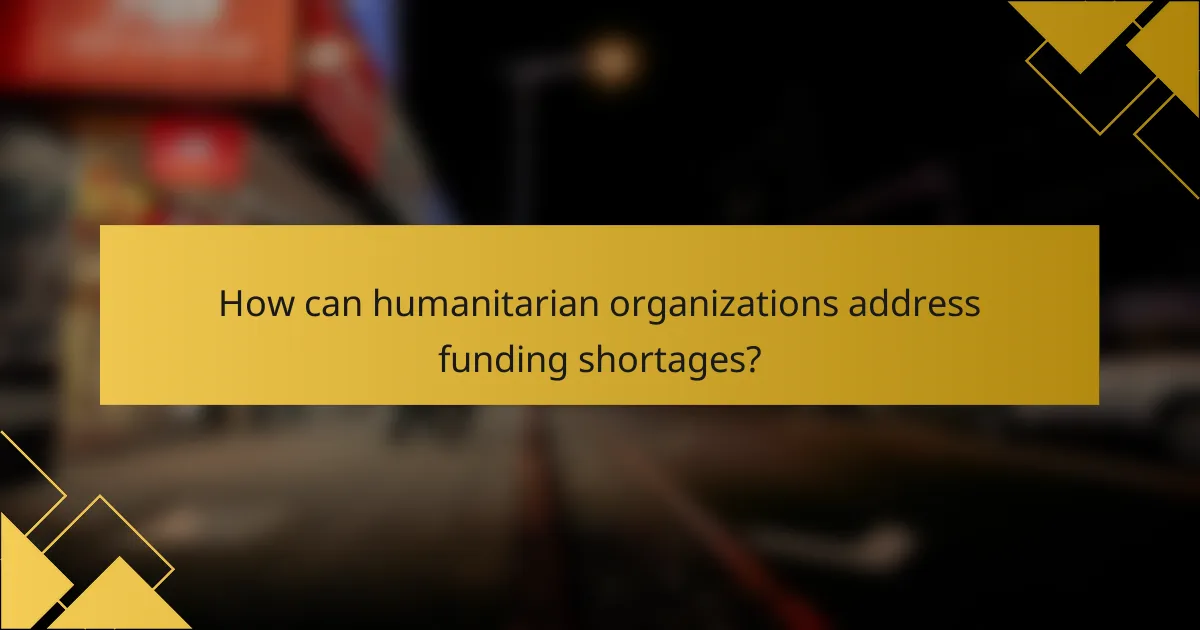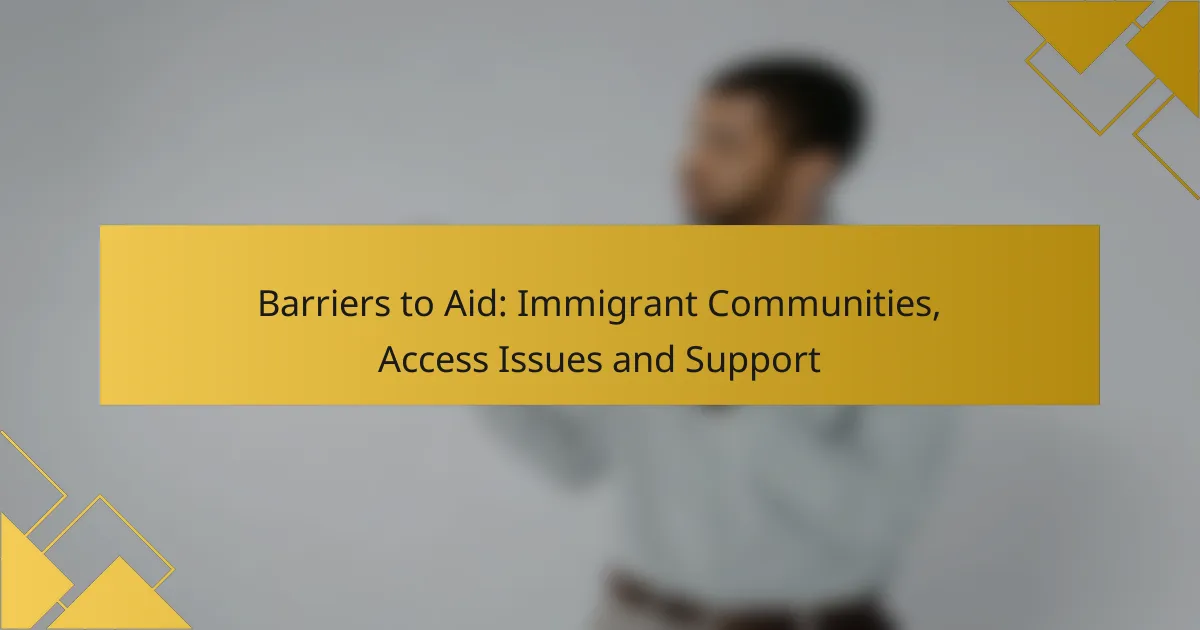Funding shortages pose significant challenges for humanitarian organizations, impacting their ability to deliver essential services. By strategically engaging with donors and optimizing resource allocation, these organizations can enhance their sustainability and overall impact. Innovative funding practices are crucial for ensuring long-term financial stability and effectively addressing the pressing needs of communities in crisis.

How can humanitarian organizations address funding shortages?
Humanitarian organizations can tackle funding shortages through strategic engagement with donors, innovative partnerships, and effective resource management. By diversifying funding sources and optimizing allocation, these organizations can enhance their sustainability and impact.
Increased donor engagement
Engaging donors more effectively can significantly boost funding for humanitarian organizations. This involves building strong relationships with existing donors and actively seeking new ones through targeted outreach and communication strategies.
Organizations should personalize their communication, demonstrating the direct impact of donations on their missions. Regular updates and transparent reporting can foster trust and encourage ongoing support.
Partnerships with private sectors
Collaborating with private sector entities can provide humanitarian organizations with additional funding and resources. These partnerships can take various forms, including sponsorships, joint projects, or in-kind contributions.
By aligning their missions with corporate social responsibility goals, organizations can attract businesses looking to enhance their community impact. This approach not only provides financial support but also leverages expertise and networks from the private sector.
Utilization of crowdfunding platforms
Crowdfunding platforms offer a modern way for humanitarian organizations to raise funds from a broad audience. By creating compelling campaigns on platforms like GoFundMe or Kickstarter, organizations can tap into the generosity of individuals worldwide.
Successful crowdfunding requires clear messaging and engaging storytelling to connect with potential donors. Organizations should promote their campaigns through social media and other channels to maximize reach and impact.
Grant applications and proposals
Applying for grants is a critical strategy for securing funding. Humanitarian organizations should identify relevant grant opportunities from governments, foundations, and international agencies that align with their missions.
Crafting strong proposals is essential; they should clearly outline the project goals, expected outcomes, and budget requirements. Organizations should also highlight their track record and capacity to manage funds effectively.
Efficient resource allocation strategies
Implementing efficient resource allocation strategies can help humanitarian organizations maximize their impact with limited funds. This involves prioritizing projects based on urgency, potential impact, and available resources.
Organizations should regularly assess their programs and adjust allocations based on performance data and changing needs. Utilizing tools like budget tracking and performance metrics can enhance decision-making and ensure funds are used effectively.

What are the impacts of resource allocation on sustainability?
Resource allocation significantly influences sustainability by determining how effectively humanitarian organizations can achieve their goals. Properly allocated resources lead to enhanced project effectiveness and foster long-term benefits for communities.
Improved project outcomes
Effective resource allocation directly correlates with improved project outcomes. When resources are strategically distributed, projects can meet their objectives more efficiently, resulting in better service delivery and enhanced impact on the target population.
For instance, allocating funds to training local staff can lead to more sustainable project management, as these individuals can continue the work beyond the initial funding period. This approach often yields higher success rates in achieving project goals.
Long-term community resilience
Resource allocation plays a critical role in building long-term community resilience. By investing in sustainable practices and infrastructure, organizations can empower communities to withstand future challenges, such as economic downturns or natural disasters.
For example, funding for local agriculture initiatives not only addresses immediate food security but also strengthens the community’s ability to sustain itself over time. This dual benefit enhances overall resilience and reduces dependency on external aid.
Effective use of limited resources
In the context of limited resources, effective allocation is essential for maximizing impact. Humanitarian organizations must prioritize interventions that offer the greatest benefit relative to their costs, ensuring that every dollar spent contributes to sustainability.
Utilizing tools like cost-benefit analysis can help organizations identify the most effective programs. Additionally, fostering partnerships with local entities can enhance resource sharing, leading to more efficient use of funds and materials.

Which organizations are leading in sustainable funding practices?
Several humanitarian organizations are recognized for their innovative and sustainable funding practices. These groups prioritize long-term financial stability and resource allocation to effectively address humanitarian needs.
International Red Cross
The International Red Cross employs a diversified funding model that includes government grants, private donations, and partnerships with businesses. This approach allows them to maintain a steady flow of resources, ensuring they can respond quickly to crises.
To enhance sustainability, the organization invests in community resilience programs that empower local populations. By focusing on prevention and preparedness, they reduce dependency on emergency funding over time.
Doctors Without Borders
Doctors Without Borders (Médecins Sans Frontières) relies heavily on private donations, which account for a significant portion of their funding. This independence from government funding allows them to operate with greater flexibility and respond to urgent medical needs without political constraints.
They emphasize transparency in their financial reporting, which builds trust with donors and encourages continued support. Their model demonstrates that a commitment to accountability can enhance sustainable funding.
Oxfam International
Oxfam International utilizes a combination of public funding, private donations, and income-generating activities to support its programs. This multi-faceted approach helps stabilize their financial base and reduces vulnerability to funding fluctuations.
Oxfam also focuses on advocacy and raising awareness about systemic issues affecting poverty and inequality. By engaging supporters in these discussions, they create a community of donors who are invested in long-term solutions, thus enhancing their funding sustainability.

What criteria should be used for funding allocation?
Funding allocation for humanitarian organizations should prioritize criteria that ensure resources are directed where they are most needed and can have the greatest impact. Key considerations include the urgency of needs, potential for positive outcomes, and geographic focus of the interventions.
Urgency of needs
Assessing the urgency of needs is critical in determining funding priorities. Organizations should evaluate situations based on immediate threats to life, health, and well-being. For example, regions experiencing natural disasters or armed conflicts typically require swift financial support to address acute humanitarian crises.
To effectively gauge urgency, organizations can use tools like needs assessments and vulnerability indices. These methods help identify the most pressing issues and allocate funds accordingly, ensuring that the most critical situations receive timely assistance.
Impact potential
Impact potential refers to the likelihood that allocated funds will lead to significant positive outcomes. Organizations should consider the effectiveness of proposed interventions and their ability to improve conditions for affected populations. For instance, funding a vaccination program in a disease outbreak zone can yield substantial health benefits.
To maximize impact, organizations should prioritize projects with proven success rates and measurable outcomes. Utilizing evidence-based practices and engaging with local communities can enhance the effectiveness of funded initiatives, ensuring that resources are used efficiently.
Geographic focus
Geographic focus is essential in funding allocation, as different regions face unique challenges and resource availability. Humanitarian organizations should consider local contexts, including socio-economic conditions, infrastructure, and cultural factors, when determining where to direct funds.
For example, funding in urban areas may require different strategies compared to rural settings due to varying access to services and support networks. Organizations can enhance their effectiveness by tailoring interventions to specific geographic needs, ensuring that resources are allocated where they can make the most difference.

How do funding shortages affect humanitarian efforts in developing countries?
Funding shortages significantly hinder humanitarian efforts in developing countries by limiting resources available for essential services. These shortages can lead to reduced program effectiveness, increased vulnerability among affected populations, and challenges in sustaining long-term development initiatives.
Impact on Resource Allocation
Funding shortages directly affect how resources are allocated within humanitarian organizations. When financial support is limited, organizations must prioritize certain programs over others, often leaving critical needs unmet. For instance, emergency food assistance may take precedence over healthcare services, which can exacerbate health crises.
Organizations may also face tough decisions about scaling back existing programs or delaying new initiatives. This can lead to a cycle of dependency, where communities are unable to recover fully due to inconsistent support.
Challenges in Sustainability
Sustainability of humanitarian efforts is severely compromised by funding shortages. Without consistent financial backing, programs that aim to build resilience in communities may falter. For example, agricultural training initiatives may be cut, leaving farmers without the skills needed to improve their livelihoods.
Moreover, the lack of sustainable funding can lead to a reliance on short-term solutions rather than long-term development strategies. This undermines the overall goal of fostering self-sufficiency in vulnerable populations.
Examples of Affected Programs
Specific programs often suffer due to funding shortages, including education, healthcare, and infrastructure development. In many developing countries, schools may close or reduce their offerings, impacting children’s education and future opportunities.
Healthcare services can also be drastically affected, with clinics operating on limited supplies and staff. For instance, vaccination programs may be delayed, leading to outbreaks of preventable diseases. Infrastructure projects, such as clean water access, often face delays or cancellations, further jeopardizing community health.










